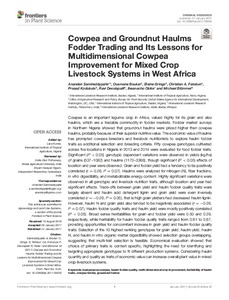| dc.contributor.author | Samireddypalle, A. |
| dc.contributor.author | Boukar, O. |
| dc.contributor.author | Grings, Elaine E. |
| dc.contributor.author | Fatokun, C.A. |
| dc.contributor.author | Kodukula, P. |
| dc.contributor.author | Devulapalli, R. |
| dc.contributor.author | Okike, I. |
| dc.contributor.author | Blümmel, Michael |
| dc.date.accessioned | 2019-12-04T11:04:54Z |
| dc.date.available | 2019-12-04T11:04:54Z |
| dc.date.issued | 2017-01-31 |
| dc.identifier.citation | Samireddypalle, A., Boukar, O., Grings, E., Fatokun, C.A., Kodukula, P., Devulapalli, R., Okike, I. and Blümmel, M. 2017. Cowpea and groundnut haulms fodder trading and its lessons for multidimensional cowpea improvement for mixed crop livestock systems in West Africa. Frontiers in Plant Science, 8, 30. |
| dc.identifier.issn | 1664-462X |
| dc.identifier.uri | https://hdl.handle.net/20.500.12478/1524 |
| dc.description.abstract | Cowpea is an important legume crop in Africa, valued highly for its grain and also haulms, which are a tradable commodity in fodder markets. Fodder market surveys in Northern Nigeria showed that groundnut haulms were priced higher than cowpea haulms, probably because of their superior nutritive value. The economic value of haulms has prompted cowpea breeders and livestock nutritionists to explore haulm fodder traits as additional selection and breeding criteria. Fifty cowpea genotypes cultivated across five locations in Nigeria in 2013 and 2014 were evaluated for food fodder traits. Significant (P < 0.05) genotypic dependent variations were observed in yields (kg/ha) of grains (537–1082) and haulms (1173–3368), though significant (P < 0.05) effects of location and year were observed. Grain and fodder yield had a tendency to be positively correlated (r = 0.26, P = 0.07). Haulms were analyzed for nitrogen (N), fiber fractions, in vitro digestibility, and metabolizable energy content. Highly significant variations were observed in all genotypic and livestock nutrition traits, although location and year had significant effects. Trade-offs between grain yield and haulm fodder quality traits were largely absent and haulm acid detergent lignin and grain yield were even inversely correlated (r = -0.28, P = 0.05), that is high grain yielders had decreased haulm lignin. However, haulm N and grain yield also tended to be negatively associated (r = -0.26, P = 0.07). Haulm fodder quality traits and haulm yield were mostly positively correlated (P < 0.05). Broad sense heritabilities for grain and fodder yield were 0.50 and 0.29, respectively, while heritability for haulm fodder quality traits ranged from 0.61 to 0.67, providing opportunities for concomitant increase in grain yield and haulm fodder quality traits. Selection of the 10 highest ranking genotypes for grain yield, haulm yield, haulm N, and haulm in vitro organic matter digestibility showed selection groups overlapping, suggesting that multi-trait selection is feasible. Economical evaluation showed that choice of primary traits is context specific, highlighting the need for identifying and targeting appropriate genotypes to fit different production systems. Considering haulm quantity and quality as traits of economic value can increase overall plant value in mixed crop-livestock systems. |
| dc.format.extent | 01-Sep |
| dc.language.iso | en |
| dc.subject | Grain Legumes |
| dc.subject | Dual Purpose Cowpea |
| dc.subject | Haulm Fodder Quality |
| dc.subject | Multi-Dimensional Crop Improvement |
| dc.subject | Heritability Of Haulm Traits |
| dc.subject | Cowpea Fodder |
| dc.subject | Groundnut Fodder |
| dc.subject | Genotypes |
| dc.title | Cowpea and groundnut haulms fodder trading and its lessons for multidimensional cowpea improvement for mixed crop livestock systems in West Africa |
| dc.type | Journal Article |
| dc.description.version | Peer Review |
| cg.contributor.crp | Livestock |
| cg.contributor.affiliation | International Livestock Research Institute |
| cg.contributor.affiliation | International Institute of Tropical Agriculture |
| cg.contributor.affiliation | United States Agency for International Development |
| cg.coverage.region | Africa |
| cg.coverage.region | West Africa |
| cg.coverage.country | Burkina Faso |
| cg.coverage.country | Niger |
| cg.coverage.country | Nigeria |
| cg.isijournal | ISI Journal |
| cg.authorship.types | CGIAR and advanced research institute |
| cg.iitasubject | Biofortification |
| cg.iitasubject | Cowpea |
| cg.iitasubject | Genetic Improvement |
| cg.iitasubject | Grain Legumes |
| cg.iitasubject | Plant Genetic Resources |
| cg.journal | Frontiers in Plant Science |
| cg.howpublished | Formally Published |
| cg.accessibilitystatus | Open Access |
| local.dspaceid | 81748 |
| cg.targetaudience | Scientists |
| cg.identifier.doi | https://doi.org/10.3389/fpls.2017.00030 |

